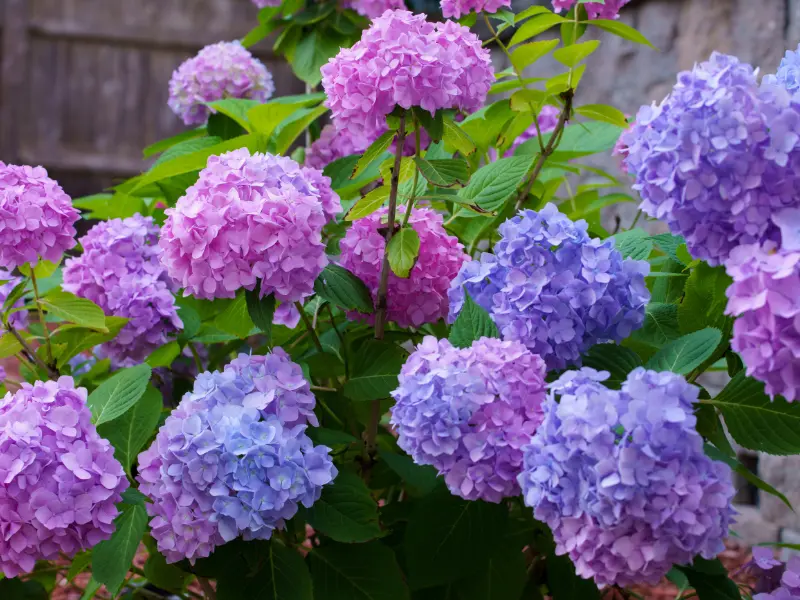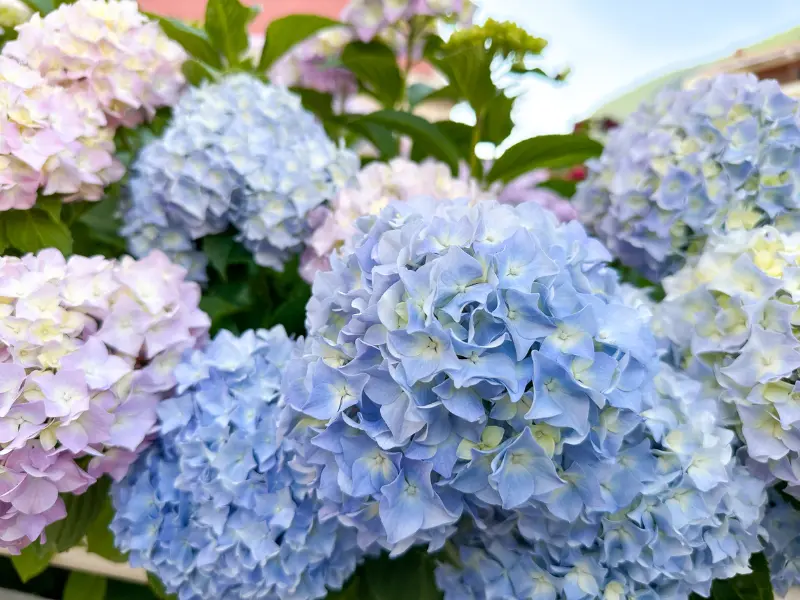Have you ever wondered why your hydrangeas are stubbornly staying pink when you were hoping for a beautiful shade of blue? Or perhaps you’re dreaming of turning your hydrangeas into a stunning display of vibrant colors, but you’re unsure where to start? Changing the color of your hydrangeas can seem like a mysterious process, but it’s actually a lot simpler than you think. Whether you want to switch them from pink to blue or vice versa, adjusting the soil pH is the key. In this easy guide, I’ll show you step-by-step how to change hydrangea color, no expert gardening skills needed!
Why Do Hydrangeas Change Color?

One of the most fascinating features of hydrangeas is their ability to change flower color. However, not all types of hydrangeas are capable of changing their hues. While some varieties only bloom in white, others can display shades of blue, pink, red, or purple. The good news is that you can influence these colors by adjusting the soil’s pH levels, whether making it more alkaline or more acidic.
The color of hydrangea flowers, especially Hydrangea macrophylla, is largely determined by the pH level of the soil they’re growing in. In simple terms:
-
Acidic soil (pH below 7) usually produces blue flowers.
-
Alkaline soil (pH above 7) typically results in pink flowers.
This means that you can easily manipulate the color of your hydrangeas by altering the pH of the soil, and in doing so, create the perfect bloom for your garden.
Which Hydrangea Varieties Can Change Color?
Certain types of hydrangeas, especially Bigleaf hydrangeas like lacecap and mophead (H. macrophyllis), are known for their ability to change color. Popular varieties include Endless Summer Twist-n-Shout, Endless Summer BloomStruck, Endless Summer Crush, Cityline Paris, Cityline Berlin, and Cityline Rio. Additionally, mountain hydrangeas (H. serrata) can also undergo color changes depending on the soil’s composition.
Read more: Top 3 Hydrangeas for Small Gardens
The Role of Soil pH in Hydrangea Color

Understanding how soil pH affects hydrangea color is crucial. The primary reason for this color change is the presence of aluminum in the soil. When the soil is acidic, hydrangeas can absorb more aluminum, which promotes the development of blue flowers. On the other hand, when the soil is alkaline, aluminum becomes unavailable to the plants, and they bloom in pink. By adjusting the pH, you can either encourage or prevent the absorption of aluminum, leading to the color shift.
How to Change Hydrangea Color: A Step-by-Step Guide
Step 1: Test Your Soil’s pH
Before making any changes to your garden, you need to know your soil’s current pH. Fortunately, testing soil pH is easy and inexpensive. You can purchase a pH testing kit from a local garden center or online. Some home improvement stores also offer testing services.
-
If the pH is below 7 (acidic), you’ll want to add amendments to make the soil more alkaline for pink blooms.
-
If the pH is above 7 (alkaline), you’ll need to make the soil more acidic to achieve blue flowers.
Step 2: How to Make the Soil Acidic for Blue Hydrangeas
To turn your hydrangeas blue, you’ll need to lower the pH of the soil, making it more acidic. Here’s how you can do that:
-
Aluminum Sulfate: This is the most effective way to acidify the soil and promote blue flowers. Add aluminum sulfate to the soil according to the manufacturer’s instructions. You can find this product at most garden centers.
-
Sulfate of Potash: This can also help acidify the soil. It’s less harsh than aluminum sulfate, but it will take a little longer to see results.
-
Pine Bark or Mulch: Adding pine bark or pine needles can naturally lower the pH of the soil over time. It’s a great option if you’re looking for a more organic approach.
Step 3: How to Make the Soil Alkaline for Pink Hydrangeas
If you’re hoping to make your hydrangeas bloom pink, you need to raise the pH of the soil, making it more alkaline. Here’s what you can do:
-
Garden Lime: Adding garden lime is the most common method for raising soil pH. Lime is widely available and easy to apply. You can find it in various forms, such as powdered or pelletized, and it will slowly increase the alkalinity of the soil over time.
-
Wood Ash: Wood ash from a fireplace or wood stove is another natural option for raising soil pH. It’s not as effective as garden lime, but it can help if you have small adjustments to make.
Step 4: Apply the Changes Gradually
Making drastic changes to the soil’s pH can stress your hydrangeas, so it’s important to adjust the soil slowly and monitor the results. Test the soil every few weeks to check the pH levels, and apply the amendments accordingly. Keep in mind that it may take several weeks or even months to see the full color change.
Step 5: Maintain the Right Soil pH
Once you’ve successfully changed the color of your hydrangeas, it’s important to maintain the proper pH for future blooms. Regularly test the soil and add amendments as needed to keep the pH within the desired range.
How Long Does It Take to Change Hydrangea Color?

Changing the color of your hydrangeas can take anywhere from a few weeks to several months, or even years, depending on how much the soil pH needs to be adjusted. This process requires patience and careful planning, but the results are definitely worth the wait!
Tips for Changing Hydrangea Color
-
Patience is key: Changing the color of hydrangeas doesn’t happen overnight. It can take a full growing season or more to see noticeable results.
-
Don’t overdo it: Adding too much aluminum sulfate or lime at once can harm your hydrangeas. Always follow the instructions on the product label.
-
Hydrangeas need the right environment: Along with pH, hydrangeas also need the right amount of sunlight and water to thrive. Make sure your plants get at least 4-6 hours of sunlight per day.
Common Mistakes to Avoid
-
Changing pH too quickly: Rapidly altering the soil pH can shock the plants, causing poor growth or unhealthy blooms.
-
Using too much aluminum sulfate: This can lower the pH too much and harm your hydrangeas. Always apply small amounts and check regularly.
-
Ignoring your hydrangeas after the color change: While pH adjustments are important, ongoing care like proper watering, pruning, and pest control is essential for healthy, vibrant blooms.
Hydrangeas Not Blooming? 5 Common Reasons Why

One of the most frequent issues hydrangea owners face is when their plants don’t bloom. If you’re struggling with hydrangeas that refuse to flower, here are five common reasons why:
-
Incorrect Pruning
As mentioned earlier, the timing of pruning is crucial. Some hydrangea varieties need to be pruned before blooming, while others should be pruned afterward. If you prune at the wrong time, you may accidentally cut off the buds (the future blooms). -
Watering Issues
Hydrangeas are known for their love of moisture – after all, “hydra” is in their name! These plants require consistently moist (but not soggy) soil. Make sure you water properly to keep them hydrated. -
Sunlight Matters
Hydrangeas thrive in a spot that gets a few hours of morning sun and some afternoon dappled sunlight. Too much direct sunlight or too little sunlight can negatively impact blooming. Find the perfect balance! -
Fertilizer Problems
If your hydrangea has lush green leaves but no flowers, your fertilizer could be the culprit. Avoid fertilizers that are high in nitrogen, and instead, use one that is rich in phosphorus (P), particularly during early spring and midsummer. -
Climate and Weather
It’s important to choose a hydrangea variety that suits your local climate zone. Even then, late spring frosts during the budding period can damage or kill the buds. If a frost is predicted, protect your hydrangea plants by covering them with a sheet until the morning.
Conclusion
Changing the color of your hydrangeas can be a fun and rewarding experience. By adjusting the soil pH, you can create stunning blue or pink blooms that will bring beauty to your garden. With the right care, patience, and regular monitoring, you’ll have hydrangeas that are the envy of your neighbors!
Now that you know how to change hydrangea color, why not give it a try? Whether you’re after the serene blues or the bold pinks, this simple process can transform your garden and bring you the hydrangeas of your dreams.
Frequently Asked Questions
-
How long does it take for hydrangea color to change after adjusting the soil pH?
-
It can take several weeks to months, depending on how much you change the pH. Be patient and monitor your plants.
-
-
Can I use coffee grounds to change hydrangea color?
-
Coffee grounds can slightly acidify the soil, but they are not as effective as aluminum sulfate or other pH-lowering products.
-
-
Is it safe to use aluminum sulfate for hydrangeas?
-
Yes, when used according to the instructions, aluminum sulfate is safe and effective for changing hydrangea color.
-
-
What Is the Best Time to Change Hydrangea Color?
- The best time to alter the soil pH and change hydrangea color is in early spring, before the growing season begins. This gives the plants plenty of time to adapt to the new soil conditions as they start to grow.
-
Can You Change the Color of Hydrangeas Year After Year?
- Yes, with regular maintenance and gradual pH adjustments, you can continue to modify your hydrangea color year after year. Just be sure not to make drastic changes too quickly, as this can stress the plant. Regular monitoring of the soil pH is key to achieving consistent results.
-
Do Coffee Grounds Change the Color of Hydrangeas?
- Coffee grounds can slightly acidify the soil, but their effect on changing hydrangea color is limited. While they may help to make the soil more acidic over time, using them alone isn’t as effective as products specifically designed to alter soil pH, like aluminum sulfate.
-
How to Make Soil Alkaline for Hydrangeas?
- To make your soil more alkaline and encourage pink blooms, you can add garden lime or wood ash. These materials help raise the pH level of the soil, making it less acidic. Be sure to test the soil regularly and apply these amendments gradually to avoid stressing your hydrangea plants.
Now that you’re equipped with all the knowledge on changing hydrangea colors, it’s time to get started and enjoy the beautiful blooms that will light up your garden. Happy gardening! Discover various hydrangea types and get expert tips on how to grow hydrangeas by visiting our website.
